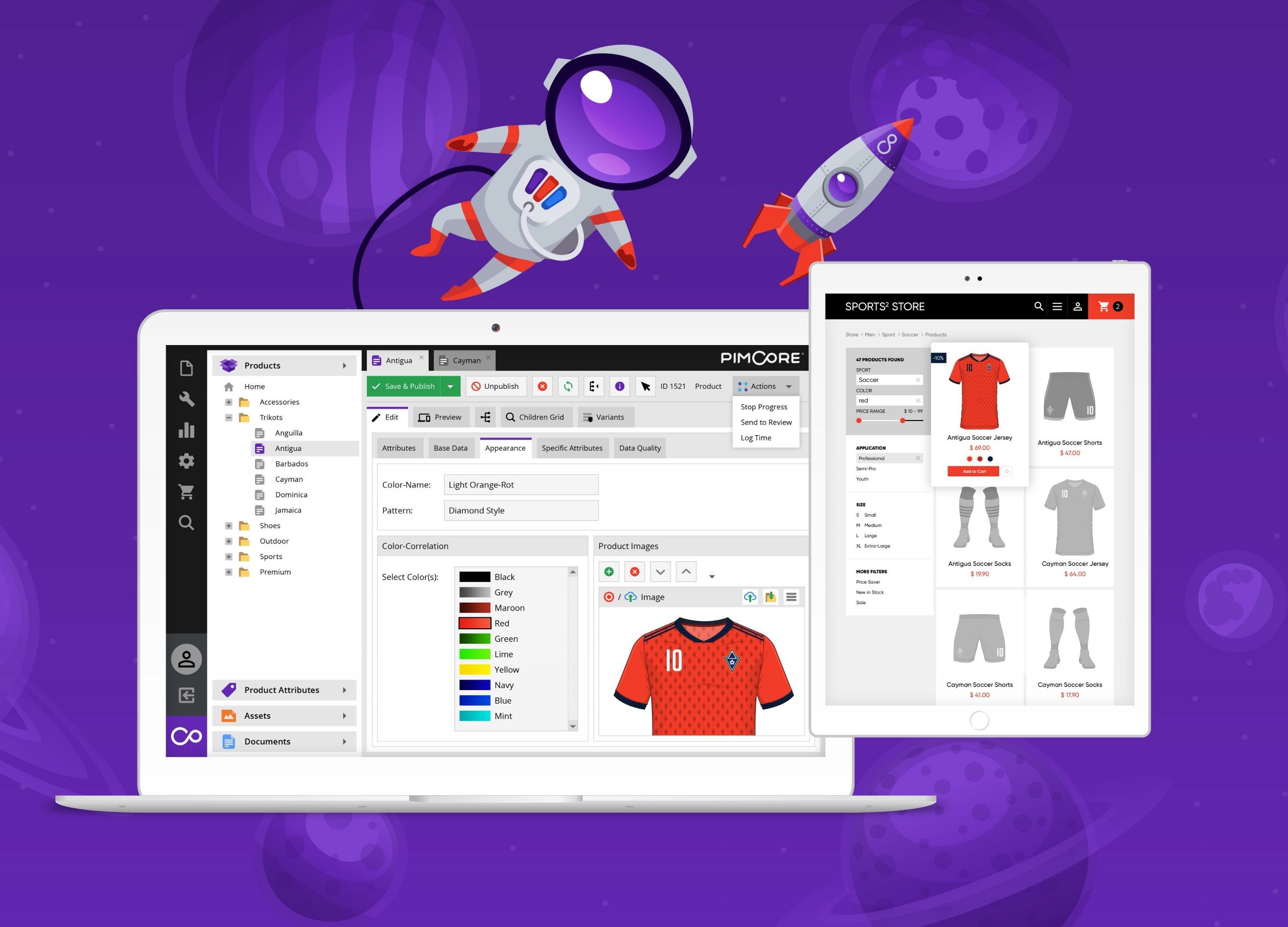Nowadays, if you are selling something, no matter what, and you are thinking about your business seriously, you need to have an online shop. Even if you didn’t believe it a year ago, 2020 taught us this lesson the hard way.
Shopping online is becoming as natural as regular shopping in a supermarket. The e-commerce market is developing at a dizzying pace. Total global sales are estimated to reach USD 6.5 trillion by 2023. Here we’re only talking about retail transactions. Also, this forecast dates before the COVID-19 pandemic, which is having a positive impact on the development of e-commerce.
So, if you don’t have your e-shop yet, you just need to choose the right solution, implement it, and wait for the first orders. In this article, we will focus on the first step – choosing the right software. Whether a particular solution will work depends mainly on its degree of alignment with your business.
What are the choices in 2021?
For the purposes of this article, we have limited the list to three popular and proven solutions:
- Shopify
- WooCommerce
- Pimcore
The decision to choose an application that will become the foundation of your business should be considered as carefully as the recruitment of employees into your company. After all, sales software replaces the cashier, customer advisor, accountant, and marketing specialist. So it is almost like hiring a whole team. This means you need to pick the one that will make your work easy and enjoyable instead of creating even more problems.
This article will help you choose the best solution. It will take into account your requirements and the complexity of your business.
I am a small business owner, and I’m starting to sell online – Shopify
Ideas should be tested with the simplest possible methods. There will come the time for expansion and conquering the world. If you want to start selling online without spending much money – choose Shopify. It is a reliable, ready-made solution in a subscription model. Think of it as the Netflix of e-commerce. A relatively low monthly fee gives you access to a comprehensive service. The only thing you need to remember is to pay your fee on time.
One registration – many options
A few minutes on registration and a little longer on configuration allow you to benefit from your own online shop. The thousands of applications and integrations prepared for Shopify give many opportunities. You can integrate it with virtually any popular service, for the most part, free of charge. You can easily add sales channels, such as Facebook and Google.
The platform has a solid base of elegant and impressive templates. Indeed, every line of business is able to find a match for itself. In most cases, the price does not exceed $200 per template. Free offers are also available.
Drop shipping? Not a problem.
Drop shipping, which has become popular in recent years, is not a challenge for Shopify either. On the Shopify blog, you will find complete step-by-step guides on how to introduce this sales model. You can count on the integration with the Oberlo service – great help when you start selling in the drop-shipping model.
Feel supported
Shopify stands out for its excellent support and publications – very-precise tips that guide you when you get stuck with a problem. They also help with integrations with external services, e.g. the configuration of the payment gateway.
Limitations
With all advantages described above, it is still crucial to be aware of the platform’s limitations. You have no way of adjusting the software. If a particular integration is not supported, it cannot be implemented. It might turn out, for example, that you won’t be able to make use of a freshly created loyalty programme. Solutions based on the classic model, in which you deploy open-source software using your own resources or an external company’s help, give much-greater scope for improvement.
Still, if you don’t want to invest too much money, for the time being, you don’t have excessive expectations, and you want to test your e-commerce idea, Shopify is a perfect choice.
I am open to expansion and new ideas – WooCommerce
In order to stand out in the marketplace and gain the trust of customers, it is necessary to act unconventionally with agility and effectiveness. In such a situation, a proven CMS comes useful. It allows you to communicate appropriate messages to the customer and provides solid support for marketing activities.
WordPress – CMS base for eCommerce
The most popular and reliable solution of this type is WordPress. It is a free, open-source platform with countless plugins and integrations. It is not an online shop but an extensive website content management system. However, you can easily turn it into an e-shop using the free WooCommerce plugin. Like WordPress itself, WooCommerce is expandable. There are plenty of add-ons and supported templates to choose from.
WordPress and WooCommerce – a perfect duo
If you’ve been considering any integration, it’s likely that the well-tuned WordPress + WooCommerce duo already has the right extension. This is the most significant benefit of this solution, but it may sometimes turn into a disadvantage. Users tend to exploit the ease of the functionality expansion, thus overloading the system with an excess of plugins. Such behaviour leads to a slowdown in operation or a loss of stability. To avoid this, we recommend a solution provided by a company specialising in WooCommerce.
The temptation of the do-it-myself approach
We understand that the prospect of using free software, organising hosting, and implementing it yourself seems to be advantageous. Yet, in the long run, there might be problems resulting from this. In the worst-case scenario, your shop might stop operating during busy hours.
If you entrust the implementation to an external company, you are likely to avoid these problems. Moreover, they will show you how to make best use of WooCommerce. In this way, you have a proven stable solution with the possibility of further development.
For small and medium-sized companies, a well-implemented WooCommerce platform is an ideal and valued solution. It is not without reason that it is the most popular platform on the market. It provides excellent flexibility and freedom of action.
I successfully sell many products online, so I need a reliable platform ready for expansion – PimCore
A well-developed, profitable business requires a solid foundation. In the case of large-scale e-commerce, you need more than just an online shop system + CMS. A more-extensive, complete set of digital products for online activities would be recommended. This niche is dominated by Pimcore, an open-source software package for more-demanding organisations. It is successfully used by Fortune-500 companies, such as Audi, Burger King, or IKEA. It should be mentioned that Pimcore also works well for slightly smaller companies 🙂
The platform consists of 6 modules:
- Product Information Management (PIM)
- Master Data Management (MDM)
- Digital Asset Management (DAM)
- Customer Data Platform (CDP)
- Digital Experience Platform (DXP/CMS)
- Digital Commerce Platform
This means that with PimCore, you gain a complete ecosystem that supports your eCommerce business. Moreover, it also helps in other aspects of business. In many organizations, Pimcore is the only tool used. For example, with this one tool, you can solve the issues of a well-organized product catalog and manage publications on many channels. Product Information Management is the flagship module of the platform.
You are not limited to product management capabilities. You can introduce any other resources into the system, each with its own characteristics and structure. Master Data Management allows you to create one source of truth with any information. This solves the problem of the flow of outdated information, which often occurs in larger organisations.
You can assign assets to all resources. Digital Asset Management allows you to create a central bank of digital resources that can be attached to data in the system, preparing it to handle any quantity and type of content. It facilitates rapid database searching. You can assign any metadata or convert the asset format – it doesn’t matter whether it’s an image or a video. The module is renowned for its capacity to maintain the consistency of all materials published by an organization. This is helpful for the cohesive communication of your brand.
Pimcore’s customer database provides more than just searching and browsing. You can easily implement increasingly popular Marketing Automation. Thanks to the Personalisation Engine, combined with notifications on multiple channels, you will substantially increase your orders’ volume.
Pimcore is a comprehensive combo drive. It means it might be too complex for small businesses. Also, you have to make sure you choose proven specialists to implement it. Only this will guarantee that you’ll acquire a scalable enterprise-class system. This will ensure that nothing will come as a surprise and block the possibility of even-faster growth.
So, what’s the right choice for me?
If you still have doubts, or can’t decide between two particular solutions after reading the suggestions presented above, come back to analyzing your needs. Consider your budget, expectations, and goals. Think about what is most important to you at this point. Are you just testing your idea? Are you already anticipating significant growth? As often happens, there are no universal answers.
Choosing the e-commerce software is a vitally important decision affecting the very basis of your business. Don’t be afraid to ask the experts. A fresh perspective can help a lot. Together you will be able to weigh up your ideas and introduce the most effective solution for your circumstances.


